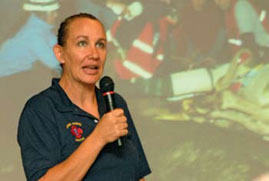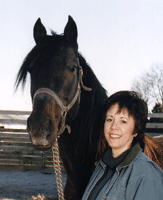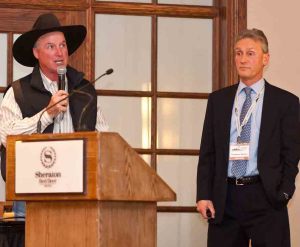Of all the expositions and conferences out there, the Alberta Horse Owners and Breeders Conference stands hands above all. It’s a serious affair, run by the  Horse Industry Association of Alberta to strengthen their community “through advocacy, education and research,” according to its mission. The days are full of lengthy educational sessions and the venue is decidedly thin on trade booths. If you’re interested in bling and silly ways to spend money on horses, stay home.
Horse Industry Association of Alberta to strengthen their community “through advocacy, education and research,” according to its mission. The days are full of lengthy educational sessions and the venue is decidedly thin on trade booths. If you’re interested in bling and silly ways to spend money on horses, stay home.
But if you like hearing about sound equine research and serious-minded, welfare-oriented advocacy, this weekend’s for you. (Plus, the cold and dreary Red Deer conditions combined with paltry dining and entertainment options will only heighten your interest in conference sessions.) It annually draws at least 500 attendees from British Columbia, Alberta, Saskatchewan, Manitoba, Ontario, New Brunswick, and the Yukon, according to conference manager Robyn Moore.
I missed this year’s event in Red Deer, but am happy to report on some highlights as provided by Moore:
-
Dr. Rebecca Gimenez presented “Emergency Preparedness on the Road and on the Trail.” Always an excellent presenter, Gimenez discussed obstacles and measures to take before and during an equine emergency.
Bottom line: If you think it’ll never happen to you, you’re mistaken. Get educated. Educate those around you. Prepare.
Read more about Gimenez and TLAER here.
- Dr. Sheryl King discussed stable management’s impact on horse behavior. The President of the Horsemen’s Council of Illinois and Professor Emeritus at Southern Illinois University Carbondale sent a clear message to those still keeping their horses in stalls: You’re harming them.
Over six years, King and her students studied the effects of confinement (full and partial, during days and/or nights). Compared with horses given 24/7 pasture access. Stalled horses (even for part of the day or night) had increased incidence of digestive disorders, hoof and musculoskeletal problems, and development of stereotypies (like cribbing and weaving). All “damaging effects of too much care,” she said. Read more about King’s research here.
Bottom line: Less is More
Read more about how Less is More and how to make a healthier environment for your horse.
Dr. Steve Peters and Martin Black presented Evidence-Based Horsemanship to a full house. The scientist-cowboy collaboration continues to serve the community and open new windows of understanding related to management and riding. Black explained what many fans have given as feedback after reading the 2011 book: “Reading a horse isn’t a new concept to me, but learning the science behind what I was seeing has given me access to better tools and a better understanding.”
Check out their book and DVD here.
Read more about Evidence –Based Horsemanship here.
Read more about the Alberta Horse Breeders and Owners Conference here.



I could not have said it better – great conference and blew me AWAY at the level of expertise and lack of bling.